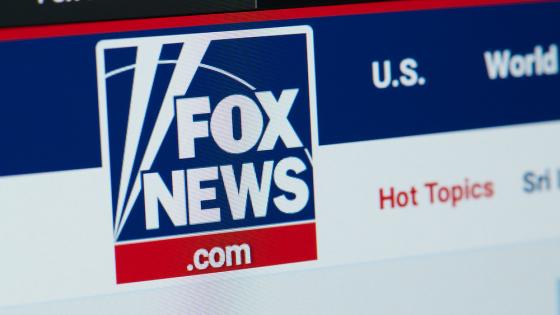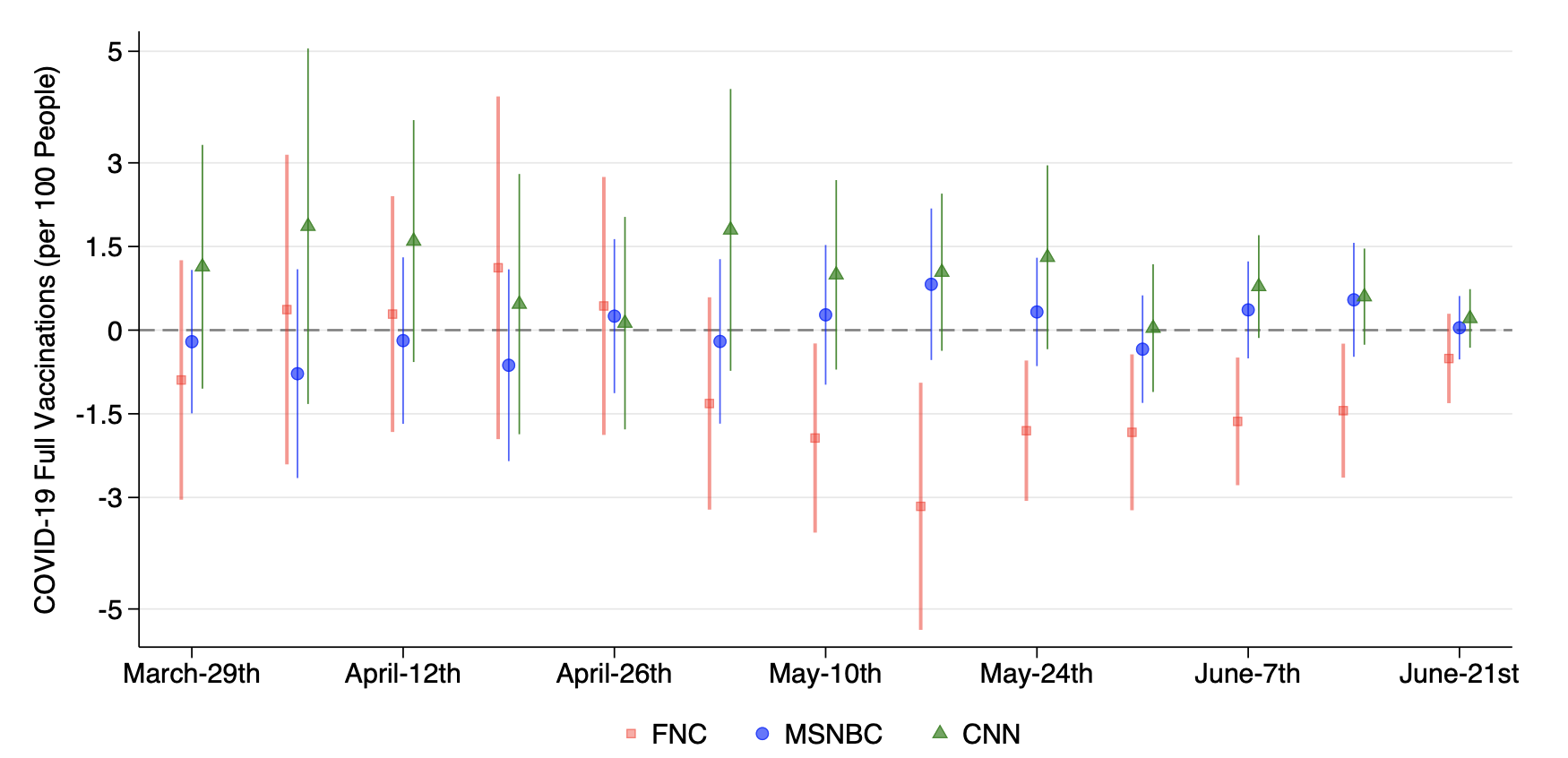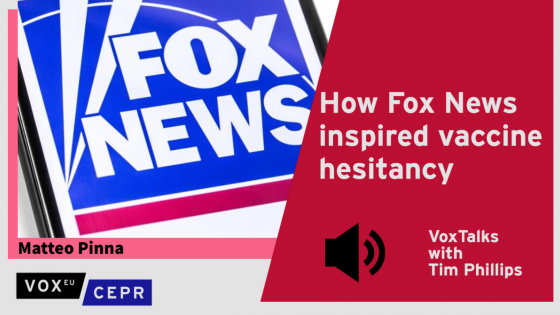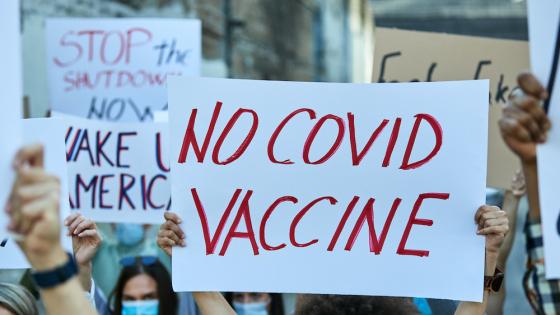Since their introduction in late 2020, COVID-19 vaccines have bolstered the fight against the pandemic, substantially reducing the likelihood of infection and especially severe cases (Amit et al. 2021, Dagan et al. 2021, Polack et al. 2020, Voysey et al. 2021). Given their proven effectiveness as well as the continued social costs of infection and public health measures like lockdowns, the persistent resistance to vaccination poses an urgent policy problem. Correspondingly, understanding the factors shaping decisions to get vaccinated or not constitutes an urgent scientific question.
Scholars have offered some initial findings. For example, exposure to online misinformation is associated with a decline in willingness to get vaccinated against COVID-19 (Loomba et al. 2021, Roozenbeek et al. 2020), and individuals who are opposed to COVID-19 vaccines are less likely to obtain information about the pandemic from traditional and authoritative sources (Murphy et al. 2021). Conservative media consumption is associated with less social distancing (Ash et al. 2020, Gollwitzer et al. 2020, Simonov et al. 2020) and worse COVID-19 health outcomes (Bursztyn et al. 2020).
At the early stages of the vaccination roll-out, news providers varied in their scepticism toward COVID-19 vaccines. Therefore, it seems reasonable to assume that differential exposure to their programmes might have influenced vaccine hesitancy and, consequentially, vaccine uptake. For example, Fox News’ primetime show Tucker Carlson, one of the most popular shows on the network, took a strong stance against vaccines, misleadingly representing deaths after vaccination as being caused by the vaccination (Barr 2021, Stelter 2021). In addition, the network has generally doubted scientific research and experts (Feldman et al. 2012, Huertas and Kriegsman 2014, Hmielowski et al. 2014).
Analysis
In order to assess the effects of media misinformation on vaccination rates, we pair data on county-level vaccination rates with data on viewership of the main cable news providers: Fox News Channel, MSNBC, and CNN. The results from the analysis show that, starting May 2021, counties with higher Fox News viewership report lower vaccination rates: watching one additional hour of Fox News per week for the average household reduces the number of vaccinations by 0.35 to 0.76 per 100 people.
In the early months of the vaccination campaign, we do not observe a relationship between cable channel viewership and vaccinations. However, starting in May 2021, Fox News viewership starts reducing vaccine uptake. The relationships for the other cable news networks, MSNBC and CNN, remain without any statistically significant effect.
Figure 1 Effect of network viewership on weekly vaccination rates (2SLS)
Notes: Regressional coefficient plots with 95% CIs of the effect of one standard deviation changes in viewership on weekly vaccinations per 100 people. Our viewership measure is instrumented using the channel line-up positions.
We observe that results are driven by people aged 18 to 65 years, with no significant effect on the group older than 65 years. To strengthen our analysis, we control for the main networks’ relative channel position and viewership, as well as for geographical confounders – including socio-demographic characteristics and political preferences of the counties.
We can show that there is a causal relationship between exposure to Fox News Channel and lower vaccination uptake. Our statistical analysis exploits the fact that networks are exogenously assigned a channel position in the television line-up, with casual viewers being more likely to watch channels with a lower channel number. We therefore use the geographical variation of the network’s channel position as an instrument for the network’s viewership. This empirical approach has been widely used in economics and political science to study the effects of biased media coverage (Ananyev et al. 2020, Ash et al. 2021, Galletta and Ash 2019, Martin and Yurukoglu 2017, Simonov et al. 2020). The causal estimates are also coherent with the correlational results of the Ordinary Least Squares regressions of viewership on vaccination rates.
Mechanism
Overall, our results support the interpretation that Fox News Channel promulgated a uniquely sceptical narrative about vaccines and that this narrative caught on and reduced uptake among the marginal vaccine recipient. We back this interpretation with the following observations.
First, in areas with higher exposure to Fox News Channel, respondents to a national survey reported higher COVID-19 vaccine hesitancy. This agrees with a behavioural mechanism where Fox News Channel’s sceptical vaccine narrative affects vaccination rates by changing attitudes and intentions regarding the vaccine, discouraging in particular the population with low health-related risks.
Second, we consider whether the effects that we see might be driven by local healthcare capacity. If the difference in vaccination rates were due to healthcare capacity, we should see similar effects throughout all stages of the vaccination campaign. Yet we find there was no effect on vaccine uptake in the early months, when the vaccines were only available to older/at-risk individuals. Thus, we infer that the effect of cable news is most pronounced for relatively low-risk individuals, such as the younger population, helping to rule out an effect due to local healthcare capacity.
It could also be that the healthcare systems in areas with higher Fox News viewership systematically differ in their capability to handle a COVID-19 outbreak, for example, due to effects on local government funding (Galletta and Ash 2019). Or it could be that these counties suffered more cases and deaths in 2020 or in the period before the vaccinations. We find that Fox News Channel has no effect on measurements of local healthcare capacity, including the number of ICU beds, number of hospitals, and Centers for Disease Control and Prevention–estimated risk indexes. We also rule out that the difference in uptake is due to differences in infections or deaths.
Third, as Fox News viewership has been shown to be correlated with voting Republican (Ash et al. 2021, DellaVigna and Kaplan 2007, Martin and Yurukoglu 2017), we check if partisan affiliation or political ideology are driving the Fox News effect. Republicans or conservatives could overall be more sceptical of the COVID-19 vaccine, indicating that the observed effect was driven by Fox News Channel increasing the number of Republicans or conservatives. Our results show that this is unlikely to be the case, as the effect of Fox News Channel on vaccine uptake holds in several tests that control for partisan affiliation and political ideology.
Finally, we consider whether Fox has affected general attitudes towards vaccines, for example through anti-science rhetoric. To check this, we look at the effects on seasonal flu vaccination rates (2017–2019) and conclude that the network does not contribute to a generic anti-vaccination sentiment and that the effect on COVID-19 vaccines is due to a COVID-specific narrative.
Conclusion
This column provides evidence that the main cable news television providers are affecting vaccination decisions, suggesting that Fox’s COVID-19 coverage is at least partially responsible for reducing vaccination rates. Fox News’ slanted media rhetoric is linked to vaccination hesitancy, producing significant behavioural effects in the under-65 population with low health risks. Future efforts by government agencies and health organisations to encourage vaccine uptake should account for how media narratives may strengthen or weaken those efforts.
References
Amit, S, G Regev-Yochay, A Afek, Y Kreis and E Leshem (2021), “Early rate reductions of SARS-CoV-2 infection and COVID-19 in BNT162b2 vaccine recipients”, The Lancet 397(10277): 875–7.
Ananyev, M, M Poyker and Y Tian (2020), “Exposure to Fox News hindered social distancing in the US”, VoxEU.org, 20 October.
Ash, E, S Galletta, D Hangartner, Y Margalit and M Pinna (2020), “The effect of Fox News on health behavior during COVID-19”, SSRN 3636762.
Ash, E, S Galletta, M Pinna and C Warshaw (2021), “The effect of Fox News Channel on US elections: 2000–2020”, SSRN 3837457.
Barr, J (2021), “Fox News viewers are getting mixed messages about whether to take the coronavirus vaccine”, Washington Post, 14 March.
Bursztyn, L, A Rao, C Roth and D Yanagizawa-Drott (2020), “Misinformation during a pandemic”, University of Chicago, Becker Friedman Institute for Economics Working Paper 2020-44.
Dagan, N, N Barda, E Kepten et al. (2021), “BNT162b2 mRNA Covid-19 vaccine in a nationwide mass vaccination setting”, New England Journal of Medicine 384(15): 1412–23.
DellaVigna, S, and E Kaplan (2007), “The Fox News effect: Media bias and voting”, Quarterly Journal of Economics 122(3): 1187–234.
Feldman, L, E W Maibach, C Roser-Renouf and A Leiserowitz (2012), “Climate on cable: The nature and impact of global warming coverage on Fox News, CNN, and MSNBC”, International Journal of Press/Politics 17(1): 3–31.
Galletta, S, and E Ash (2019), “How cable news reshaped local government”, SSRN 3370908.
Gollwitzer, A, C Martel, W Brady, P Pärnamets, I Freedman, E Knowles and J Van Bavel (2020), “Partisan differences in physical distancing are linked to health outcomes during the COVID-19 pandemic”, Nature Human Behaviour 4: 1–12.
Hmielowski, J D, L Feldman, T A Myers, A Leiserowitz and E Maibach (2014), “An attack on science? Media use, trust in scientists, and perceptions of global warming”, Public Understanding of Science 23(7): 866–83.
Huertas, A, and R Kriegsman (2014), Science or spin? Washington, DC: Union of Concerned Scientists.
Loomba, S, A de Figueiredo, S J Piatek, K de Graaf and H J Larson (2021), “Measuring the impact of COVID-19 vaccine misinformation on vaccination intent in the UK and USA”, Nature Human Behaviour 5(3): 337–348.
Martin, G J, and A Yurukoglu (2017), “Bias in cable news: Persuasion and polarization”, American Economic Review 107(9): 2565–99.
Murphy, J, F Vallières, R P Bentall et al. (2021), “Psychological characteristics associated with COVID-19 vaccine hesitancy and resistance in Ireland and the UK”, Nature Communications 12(1): 29.
Polack, F P, S J Thomas, N Kitchin et al. (2020), “Safety and efficacy of the BNT162b2 mRNA Covid-19 vaccine”, New England Journal of Medicine 383(27): 2603–15, PMID: 33301246.
Roozenbeek, J, C R Schneider, S Dryhurst et al. (2020), “Susceptibility to misinformation about COVID-19 around the world”, Royal Society Open Science 7(10): 201199.
Simonov, A, S K Sacher, J-P Dubé and S Biswas (2020), “News media and distrust in scientific experts”, VoxEU.org, 6 July.
Stelter, B (2021), “Tucker Carlson’s Fox News colleagues call out his dangerous anti-vaccination rhetoric”, CNN Business, 6 May.
Voysey, M, S A Costa Clemens, S A Madhi et al. (2021), “Single-dose administration and the influence of the timing of the booster dose on immunogenicity and efficacy of ChAdOx1 nCoV-19 (AZD1222) vaccine: A pooled analysis of four randomised trials”, Lancet 397(10277): 881–91.








